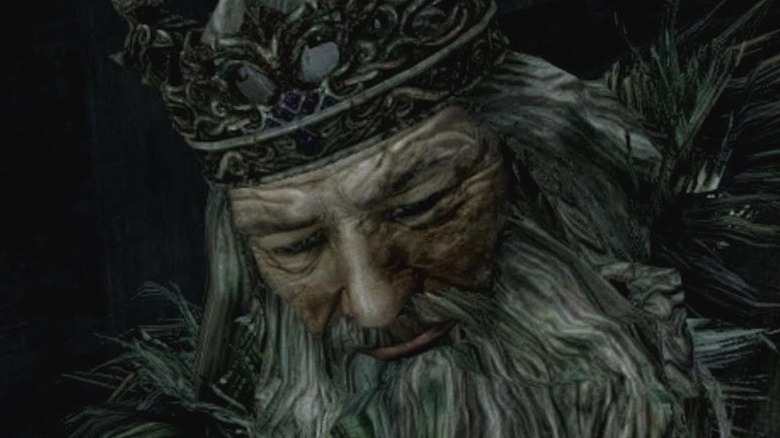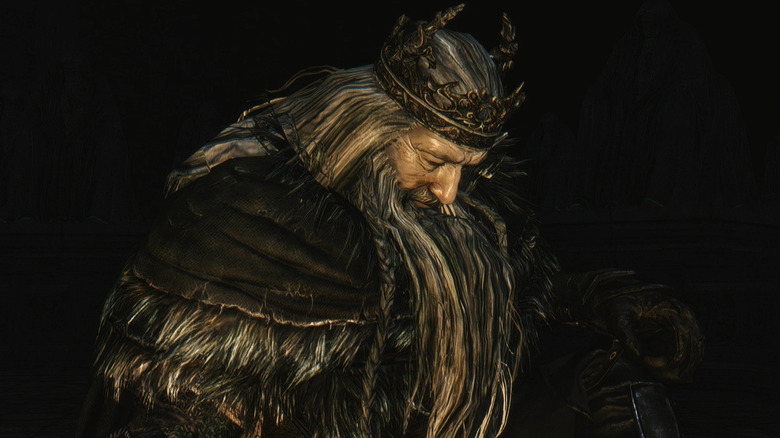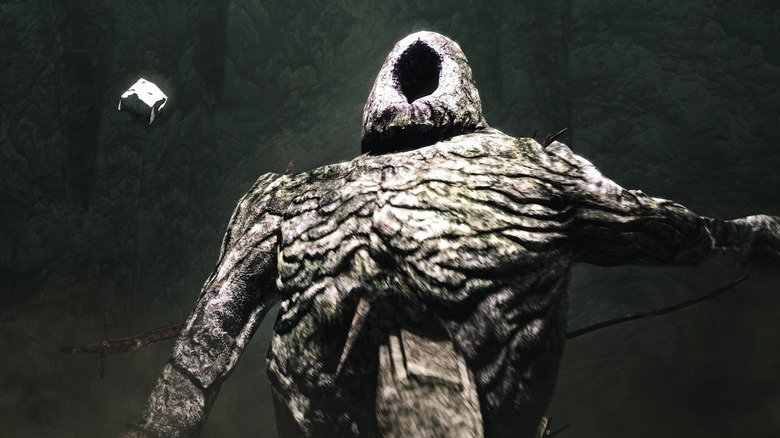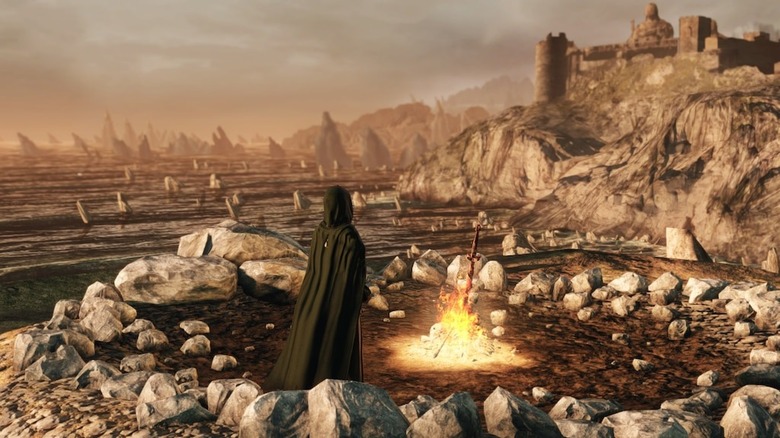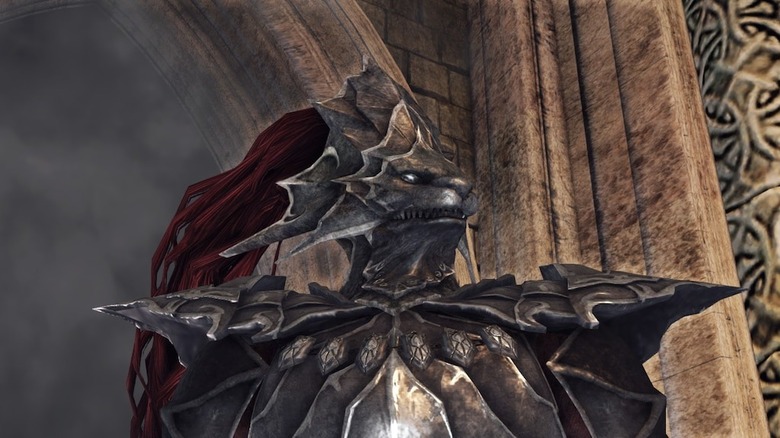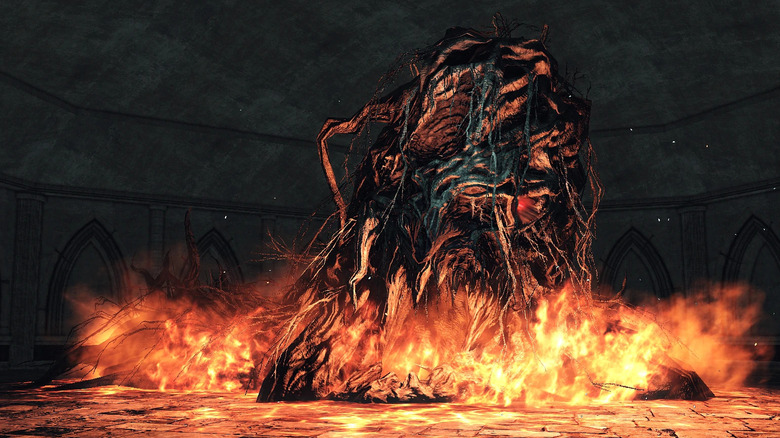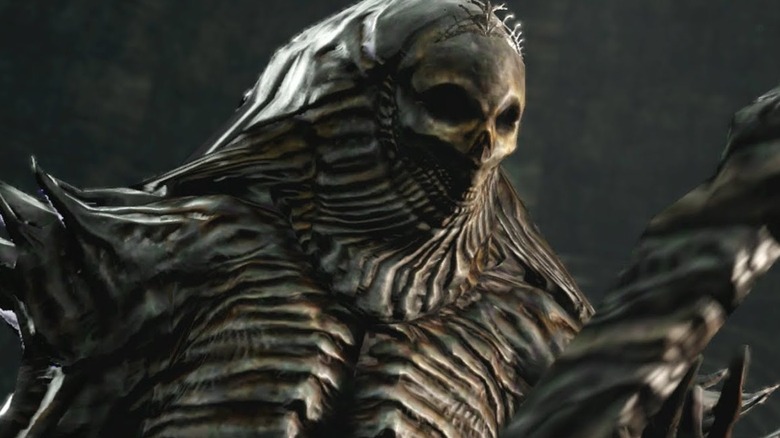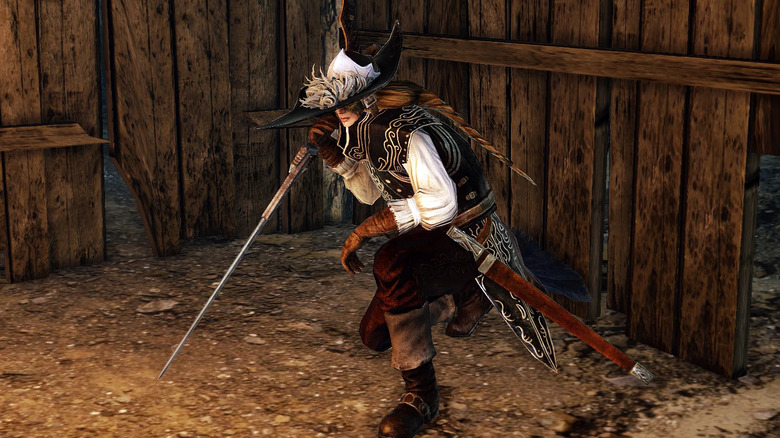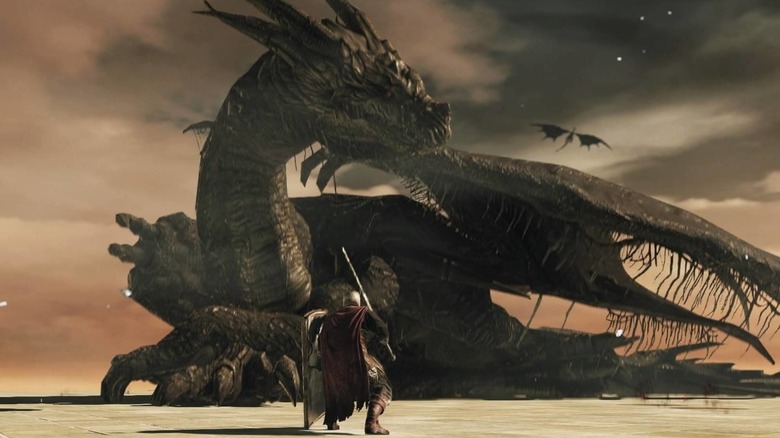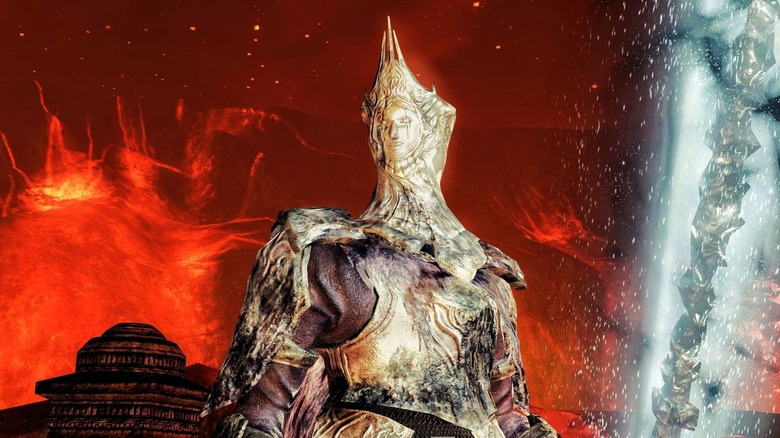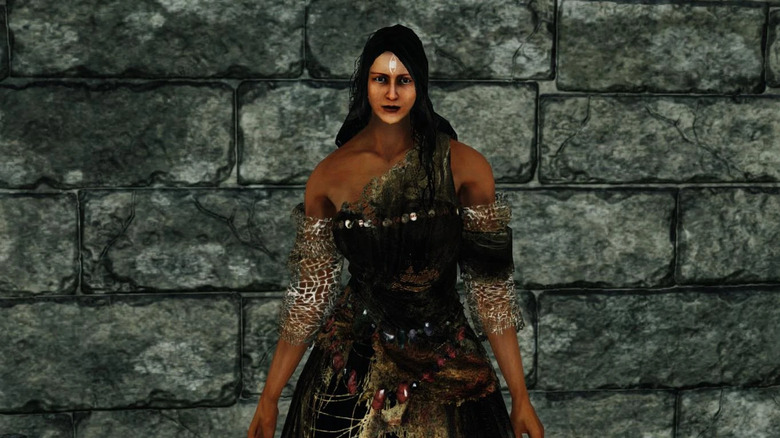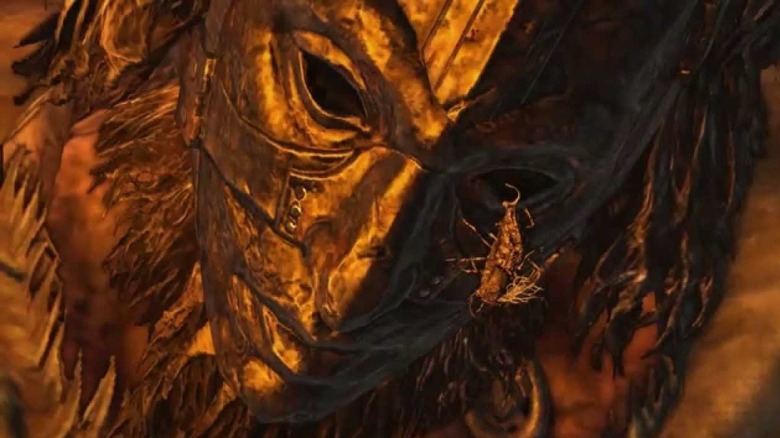Tragic Details You Missed In Dark Souls 2
"Dark Souls 2" is the black sheep of the "Dark Souls" trilogy, and some have even considered it to be the worst of the "Souls" games. While the game's certainly not without its flaws, the storytelling in "Dark Souls 2" is among the richest FromSoftware's consistent library of worlds has to offer. It is the dark middle chapter of a series that is already full of tragedy.
No different from "Demon's Souls" or "Elden Ring," the world of "Dark Souls 2" is dense with characters and locations that have rich histories. Players are thrust into a world on the edge of collapse, and the sequel to "Dark Souls" takes an even more melancholy tone than its predecessor. If you take the time to read the many item descriptions, follow through with the characters you meet, and even spend some time digging around in fan theory discussions, you'll find "Dark Souls 2" contains a rewarding world that's worth getting lost in.
Some of the most tragic characters in all of FromSoftware's catalogue can be found in "Dark Souls 2." There's a good chance you've played the game to completion and still missed some of these tragic details sprinkled throughout the world of Drangleic.
The Tragedy of King Vendrick
King Vendrick has got to be in the running for most tragic figure in the whole "Dark Souls" canon. As you close in on Drangleic Castle, the protagonist begins to hear more and more about the King. When you enter his dark boss arena to find him walking madly in circles, it feel like an anti-climactic moment. But it is also a haunting one — if you have been paying attention to the lore.
Vendrick rose to power with the help of his brother Aldia. He eventually met a beautiful woman named Nashandra, who convinced him to go to war with the Giants. Years of battling between the two factions caused the once-great Drangleic to fall into disrepair. As the First Flame began to fade, an Undead Curse started to inflict the denizens of Drangleic. Rejecting the choice between rekindling the flame and letting it fade, Vendrick searched for another answer, but all he found was Nashandra's true identity as a wicked child of Chaos. In order to prevent her from ushering in darkness, Vendrick separated his Soul from his body and sealed himself away in the crypt — where the you'll eventually find him wandering.
Knowing this, the encounter with the oblivious Vendrick is an eerie experience. You can take him on and defeat him, but it may feel like a hollow victory.
You must kill the Last Giant
The hulking Last Giant is the boss most players will encounter first in "Dark Souls 2." He seems like a pushover at the time of the battle, especially if you've played other "Souls" games, but you don't yet know what made this giant so weak. You have to play through a lot more of the game to learn why the Last Giant is such a pitiable figure.
Learning about King Vendrick's war with the Giants re-contextualizes this early part of the game. The Forest of the Fallen Giants and the Last Giant are remnants of the Giant's retaliatory strike on Drangleic, which they launched after Vendrick invaded their land.
In "Scholar of the First Sin," you learn even more about this period of history by revisiting memories of Vendrick's war against the Giants. The Last Giant was a powerful Giant Lord who has been locked in a dungeon for decades. His strength has clearly faded during his imprisonment, since this is a fairly trivial boss fight. In retrospect, that fragility makes the fact that you are slaying the last of a long-lost species a truly tragic moment. You just don't realize it until 50 hours later.
The strange case of Majula's sun
"Dark Souls 2" defenders typically have high praise for the game's atmospheric hub town, Majula. The coastal town is full of NPCs that feel like characters living their daily lives. And beneath Majula, there are secrets abound. One detail fans have noticed about the game's mysterious starting village is that the sun seemingly never rises or sets; it stays in a fixed position.
Dedicated "Souls" fans have concluded that the lighting and the position of the Sun in Majula support this theory. This obviously speaks to the cyclical nature of the stories FromSoftware tells in these games. As one fan pointed out on Reddit, "a rising sun emerges from the horizon as the world become lighter, and a setting sun moves closer to the horizon as the world grows darker."
Whether the world is moving towards darkness or light is up to the player — not just in the ending that you choose, but how you choose to interpret its meaning. The death (or sunsetting) of one era can also be interpreted as the birth of a new one. One age's sunrise could be another's sunset.
The identity of the Old Dragonslayer
An optional boss you can find fairly early on in "Dark Souls 2," the Old Dragonslayer is an echo of a past foe, as well as one of the game's few direct references to its immediate predecessor. The Old Dragonslayer is a callback to Dragon Slayer Ornstein, one half of the legendary duo of Ornstein and Smough, who make up one of the most life-ruining boss battles in "Dark Souls."
The visual design of the Old Dragonslayer's armor is the first clue that will jog your memory. Once you begin the boss fight, you will notice he has a similar move set to Ornstein's, as well. And of course, the character's very name feels like a direct reference to the Dragon Slayer previously seen in "Dark Souls."
There are lots of theories regarding the exact connection between the two characters, some of which have been rounded up by The Artiface. We know that "Dark Souls 2" takes place many years after the original, but whether Drangleic in the same part of the world as Lordran is still a mystery. This boss could somehow be a still-living Ornstein, or some sort of reincarnation of the long-dead warrior. This would suggest, too, the heartbreaking idea that Dragonslayer resides in the Cathedral of Blue because it reminds him of the buildings Anor Londo, his home.
Another theory posits that the Old Dragonslayer could have been a student of Ornstein who decided to flee from Lordran before the events of the first game. This would be an especially tragic fate for the character, since they fled one dying kingdom to wind up in another.
Aldia, Scholar Of The First Sin
Aldia is a character so crucial to the plot of "Dark Souls 2," it's a surprise he wasn't in the original release of the game. The titular Scholar of the First Sin, Aldia, was added as an important and mysterious NPC in the expanded re-release of "Dark Souls 2." If you are playing the "Scholar of the First Sin" edition, he also serves as the game's final boss.
Aldia speaks to you throughout the second half of "Scholar of the First Sin," but there is a lot more to the character than what he communicates directly. Even half the stuff he tells you is nearly impossible to interpret if you don't have a "Souls" lore bible on hand.
In the mythology of "Dark Souls 2," Aldia was King Vendrick's older brother. Although Vendrick and Aldia were once allies, Aldia began showing unusual interest in the Undead and the origin of the Undead Curse. Vendrick locked his brother up for this, but Aldia's quest for knowledge about the origin of the undead curse drove him insane, leading him to become a monstrosity that lives within the world's bonfires. Even after he became cursed, he continued his pursuit for knowledge, seeking out the protagonist — the Chosen Undead — to guide him towards the Throne of Want. And so, this once-noble being is now a horrific and unintelligible shadow of its former self.
Nashandra's origins
Nashandra, the ultimate villain and final boss of the original version of "Dark Souls 2," has a surprising connection to the original "Dark Souls." According to the official lore, Nashandra was born from a shard of Manus, Father of the Abyss. If you played the "Dark Souls" DLC "Artorias of the Abyss," you'll probably recognize Manus as the tough cookie battled at the very end of the final Abyss area. Basically, Nashandra's existence is a direct result of Manus meeting his end at the hands of the Chosen Undead in "Dark Souls."
When Manus was defeated in "Artorias of the Abyss," his soul shattered into fragments, some of which became self aware entities. One of these became Nashandra, who would eventually go on to corrupt Vendrick and cause the downfall of Drangleic.
Nashandra is a prime example of a "Souls" character who has created their own tragedy. In a ruthless quest to rule Drangleic, Nashandra led the kingdom to ruin. By the time she sat atop the throne, the kingdom was a shadow of what she once sought to conquer. Not only that, but her final hope — leading the Chosen Undead to the Throne of Want — is what kills her in the end. The fact that your own heroic actions in a previous game leads to all of this pain just makes things feel even more hopeless in the world of "Dark Souls."
Lucatiel's hollow journey
During your journeys through "Dark Souls 2," you will run across many fellow Undead. In fact, Lucatiel of Mirrah is an NPC who shares the same curse as you — only their fate is much less blessed.
When you first discover Lucatiel at No Man's Wharf, you'll notice she is wearing a mask. If you talk to her, you'll learn that her fascination with Hollowing comes from a desire to reverse her own affliction. As the quest goes on, she begins to tell the player of her fading family memories. If you follow Lucatiel's quest line, you will be forced to watch her Hollow slowly over time. As the game continues, Lucatiel loses her memories and all sense of self. At the end of her quest line, Lucatiel asks the Chosen Undead to remember her name.
The cherry on top of Lucatiel's tragedy is that her brother Aslatiel lost himself searching for a cure to the Undead curse, which also ruined his life. Searching through the world of Drangleic, you can actually find Aslatiel as a phantom at Aldia's Keep. And as expected in a game of difficult battles like this, you can choose to fight him.
The Ancient Dragon died long ago
There is a prevalent fan theory in the "Dark Souls 2" community that the Ancient Dragon you meet near the end of the game isn't actually a real dragon. The implications of a single item drop have unraveled into one of the wildest breadcrumb trails of lore you'll find in a "Souls" game.
When you meet the Ancient Dragon at the Dragon Aerie, you don't have to fight him to get the Ashen Mist Heart, which allows you to travel into the memories of giants. However, if you choose to fight the Ancient Dragon, you can kill the beast. When killed, it drops a Giants Soul, which has led some fans to believe that this so called "dragon" is an imitation created by Aldia using a Giant's Soul.
Later, when you are wandering through the eerie Dragon Memories, you can see the actual soul of the Ancient Dragon after its death, which would imply that it died long ago. Even if you don't fight the Ancient Dragon, finding its soul in this memory will lead you to the truth. It was tragic enough to kill this noble beast when you didn't necessarily have to, but finding out that it was a copy of a wise dragon that died many years ago might be even more strange and upsetting.
The Ivory King was once a heroic leader
Each of the DLC expansions for "Dark Souls 2" transport you to different kingdoms, each of which has been through a tragedy echoing those of Vendrick in Drangleic. In the final DLC, "Crown of the Ivory King," you enter the frozen kingdom of Eleum Loyce.
Eleum Loyce was ruled by the Ivory King until Chaos overtook the kingdom. Its leader descended into the Chaos as its first line of defense, but quickly fell. Of all the kings glimpsed in the vast "Dark Souls" story, the Ivory King might be the most noble. He was not strong enough to protect his kingdom, but he was brave enough to try. In fact, he built his entire castle on top of a Chaos mouth in order to slow the spread at all costs.
You see just how strong The Ivory King was in his prime when you play the DLC area. The protagonist is tasked with finding up to four Knights of Eleum Loyce to help in the battle against their fallen King. The fight is nearly impossible without at least two of these NPC companions, proving just how powerful the Chaos has made the once-noble ruler.
Rosabeth of Melfia should have stayed petrified
In "Dark Souls 2," you can use a Fragrant Branches Yore to clear paths blocked by petrified enemies and NPCs. And one of the friendlier characters you can set free from petrification is the tragic Rosabeth of Melfia. Unfortunately, as it turns out, you might have just made her life worse by setting her free.
Rosabeth explains that she was once a promising student of Pyromancy. But one day, her master — sorcerer Carhillion of the Fold — went missing. On her search to find him, Rosabeth was turned to stone by a Basilisk (not a giant snake in "Dark Souls," by the way; just those pesky little frog-like guys everyone hates in these games). It's worth noting that you'll eventually run into Carhillion as well in your adventures, and he is a mysterious and shady fellow.
Rosabeth eventually decides that she does not want to find her former master after all. Fans have quite a few dark theories as to why this could be. In a snippet of her dialogue with the player, Rosabeth admits she used to study with the Pyromancer Gloken before following Carhillion. This information could give her a handful of conniving motivations for finding Carhillion, either to spy on him or assassinate him. Some fans in the thread have also pieced together a dark theory that Carhillion may have been truly horrible to Rosabeth when she was younger, which would add a whole other layer to her apprehension towards finding the enigmatic sorcerer.
The Lost Sinner is punishing herself for eternity
This is one of those classic, easy-to-miss tragedies that is littered throughout the ancillary item descriptions in the "Souls" series. It also lends new context to a relatively tame early-game boss, the Lost Sinner. The boss of Sinner's Rise is a tall woman with her hands cuffed around a giant sword. There are plenty of dark details hidden among the items you'll find after defeating her.
When you read the item description for the Lost Sinner's Soul, for instance, you learn that the Lost Sinner had chained herself for eternity as a way of trying to atone for all her sins. A line in the description about her self-imposed torture is reinforced by the armor she wore during the boss fight.
After the Lost Sinner fight, you can also purchase the Penal Mask that she wears. The description of the mask reads as follows: "The spikes pointing inward suggest that this was not only use to bind prisoners, but to torture them as well." A haunting image, indeed. What could she have done that haunted her enough to want to inflict never-ending pain upon herself?

